und Wörterbuch
des Klassischen Maya



Two Vessels from Xultun Workshops in the Tikal Center for Conservation and Research
Research Note 23
DOI: https://doi.org/10.20376/IDIOM-23665556.21.rn023.en
Guido Krempel (Rheinische Friedrich-Wilhelms-Universität, Bonn)
Sebastián Matteo (Indepedent Researcher)
Dmitri Beliaev (Russian State University for the Humanities/Higher School of Economics, Moscow)
During the past decade the corpus of inscriptions pertaining to the Baax Witz court of Xultun has been significantly amplified thanks to recent archaeological investigations (e.g., Rivera Castillo and Saturno 2014; Saturno and Beltran 2016; Saturno et al. 2015, 2017; Hurst and Beltran 2020; Rossi 2015; Rossi and Stuart 2020) as well as newly identified polychrome vessels with dedicatory texts in private and institutional collections (e.g., Krempel and Matteo 2012, 2013; Matteo and Krempel 2011, 2020; Polyukhovych and Looper 2019). Here we present two heretofore unpublished polychrome vessels of unknown provenance (Figures 1-3 and 7-9), both of which can be ascribed to the pottery workshops of Xultun. One of these vessels provides us with additional evidence for Ix Yax We’n Chaak, a female ruler whose existence has just recently been revealed thanks to new in situ finds (Hurst and Beltran 2020:209-211; Rossi and Stuart 2020). The other fragmented vessel can, by means of a comparative analysis, stylistically be attributed to a Late Classic palace workshop of Xultun that operated during the reign of Yax We’n Chan K’inich (e.g., Garrison and Stuart 2004; Krempel and Matteo 2012, 2013).
Both vessels were likely confiscated from looters who got caught with their contraband goods in the Tikal area. Unfortunately, no information about their original place of encounter is known to us. In May of 2013, the two vessels were documented in the course of the Atlas Epigráfico de Petén Project, directed by Dmitri Beliaev, which had its focus on the documentation of Maya inscriptions in the storages of the Tikal National Park. They are currently preserved in the Tikal Center of Conservation and Research (Centro de Conservación e Investigación de Tikal, CCIT) among other ceramic objects (see also Beliaev and de León 2013:340-346; Beliaev et al. 2015:680-681).
A cylindrical vessel mentioning Ix Yax We’n Chaak
The first here discussed vessel is a restored vessel registered as “Vaso #8”. It measures 23 cm in height and 9.1 cm in diameter (Beliaev and de León 2013:343). This cylindrical drinking cup has an elongated, slightly barrel-shaped form (Figures 1-3).
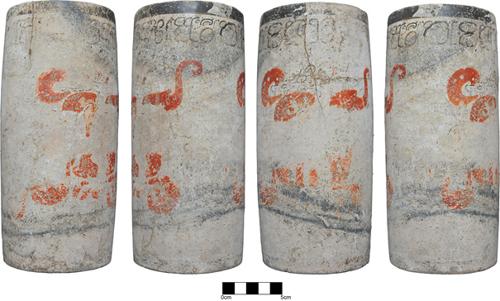
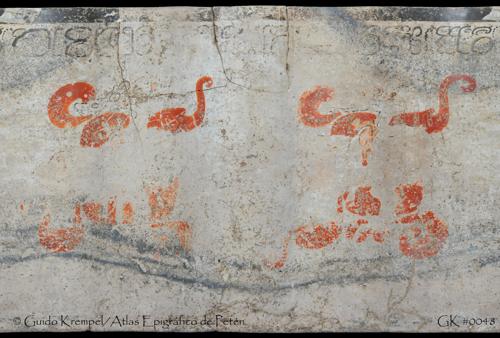
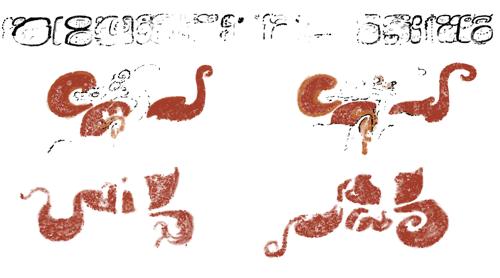
It is adorned with two thick black horizontal lines, one decorating the upper rim and one at the bottom. Below the upper black rim is painted a dedicatory text that is partially eroded. The body of the vessel has a white slip and is decorated in the central section with two repeating motifs. The imagery is, however, barely recognizable due to the heavy abrasion of the vessel surface. Still discernible are remains of a central anthropomorphic figure, the upper part of its head being preserved on one side, and the head of a long-necked creature on top being visible on both sides. Out of the creature’s mouth are emerging volutes that are painted in gaudy red and orange hue. While the black contours of the figure as well as the body of the zoomorphic creature are almost completely eroded, the thick red volutes coming out of its mouth and enclosing the entire motif are still clearly visible.
The dedicatory text consists of twelve glyph blocks, six of which are severely abraded. Notwithstanding the advanced damage, most of the text can still be read or reconstructed, except for two glyph compounds that are almost completely gone and therefore not deducible anymore:
(1) UH?/T’AB? (2) u-tz’i-bi (3) na-ja (4) yu-k’i-bi (5) ti-yu-ta* (6) ka-ka-wa** (7) yo?-[…] (8) […] (9) […] (10) YAX-IX[WE’-CHAAK]-ne (11) BAX-WITZ-AJAW (12) ba-ka-ba
uh[uy]?/t’ab[ayi]? utz’i[h]bnaja[l] yuk’ib ti yuta[l] kakaw? [...] ix yax we’n chaak* baax witz ajaw bakab
“It got sanctified? (it got raised?) the painted drinking cup for fruity cocoa (of) yo?[…] […] Ix Yax We’n Chaak, sovereign of Baax Witz, chief of the land”
Remarkably, the text does not start with the usual initial a-ALAY-ya but instead begins directly with the dedicatory verb. The absence of the initial term alay is not unique and known from Xultun ceramics, especially when used in conjunction with the intrinsic (not yet firmly deciphered) dedicatory verb(s?) utilized here. On two other ceramics originating from Xultun workshops the initial sign is likewise absent: K5976 (dedicated to Ix We'om Yohl Ch'e'n), and K8007 (dedicated to Ix Yax We’n Chaak), the latter also having been confiscated from looters in the Tikal area (see Figure 4a). The text starts with a head variant of the dedicatory verb depicting a male head or skull with “breath”-element that is foremost attested in the region around Uaxactun, Xultun and the (north-) eastern Peten. A possible reading UH-yi uhuuy “got sanctified(?)”, was first proposed by Nikolai Grube (Grube and Gaida 2006:66). In the here attested case it could be merged with the ‘God N-dedicatory verb’ with the reading value T’AB (Stuart 1998:416-417; Martin 2015:206, note 29; Zender 2005:11-12; Helmke, Beliaev and Vepretskii 2020). When appearing in combination, as is scarcely attested (see K2914, from the Rio Azul region), the two signs seem to be merged, and, to our current knowledge, there is so far no evidence for the occurrence of UH-yi and T’AB-yi following each other, reason why it is not yet clear if the merged variants have just one reading (see, for example, Zender 2019:30, note 4) or if, eventually, both dedicatory verbs have their proper reading value. The initial verb is then followed by the generic term for the vessel function and intended content: “the painted drinking cup for fruity cacao” (Beliaev, Davletshin and Tokovinine 2009:258-260). Note that this section is almost identical in calligraphic rendering and textual content compared to the other confiscated vessel from Xultun (the already mentioned K8007, today exhibited in the Museo Sylvanus G. Morley in Tikal, Inv. No. 394-83-1; see Figure 4a).
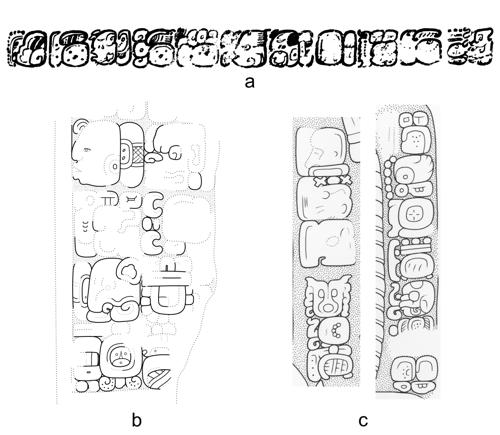
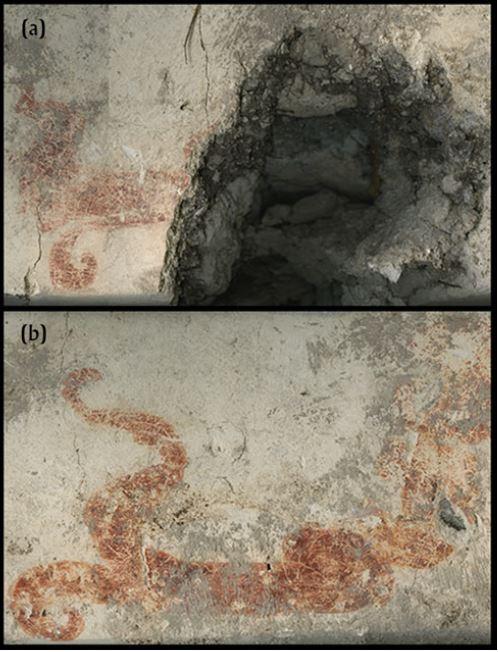
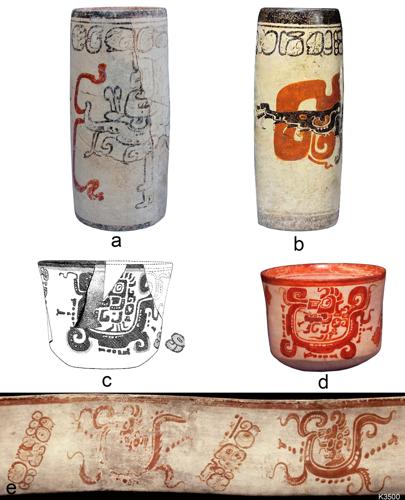
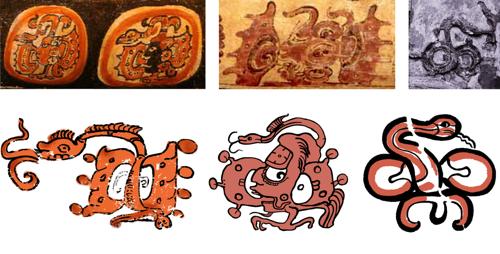
However, in the here presented case there is reason to assume that the eroded zoomorphic creature neither resembles a scorpion, nor a snake or centipede but instead might represent the so called “shell-wing dragon” (Hellmuth 1987:167-179), a zoomorphic representation of an animated conch or mollusk (Figure 7; see also, e.g., K4958, K6167). Due to the advanced erosion, it appears hard to draw final conclusions, nonetheless, we tentatively propose that the anthropomorphic heads with flat forehead and ear jewelry painted in the center could either represent the head of the Maize God, or, alternatively, might have represented portraits of the vessel owner Ix Yax We’n Chaak that were merged with the body of the “shell-wing dragon”. Notably, the “shell wing dragon” can be merged with different deity heads (as well as bird-features), among them the Maize God, the Sun God (K’inich Ajaw), G1, as well as God N, for which the advanced state of abrasion makes it hard to spot its identity in the here depicted instances.
A fragmented Zacatel Cream-polychrome: Panela Variety vessel (PNTF-192, Inv. No. 17.1.1.3815)
The second, here presented vessel is a fragmentary low bowl with vertical walls said to proceed from the looting somewhere in the Uaxactun region to the north of Tikal. It measures 12 cm in height and 35 cm in diameter (Beliaev and de León 2013:343). Approximately 20% of the material is missing. Except for one sherd, all remaining fragments can be reassembled to a coherent body (Figures 8-10).



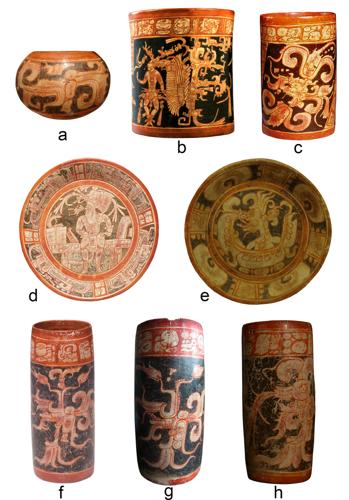
While most of these vessels are of unknown provenance, at least a couple of examples bear the name and regal titles of Xultun’s best-known 8th century ruler Yax We’n Chan K’inich (K4752, K9271; Krempel and Matteo 2012:150-154, 2013). A comparative analysis of the calligraphy and style leads to assume that some other ceramics are directly related to this last set (see Figure 11a,f,g) and, thus, can convincingly be attributed to a Xultun pottery workshop, eventually even to one single scribe (Krempel and Matteo in prep.). All that implies that one of the main production loci of the Zacatel Cream-polychrome: Panela variety pottery were the palace workshops of Xultun (see also Krempel and Matteo 2012:150-154; 2013), even though at least one of the finds from Uaxactun (Smith 1955:Figs. 3c, 80h) seems to bear the dynastic title K’AN-na-wo?-ko-ko (see also Safronov and Beliaev 2017), thus likely relating it specifically to Uaxactun. Note that a similar title ascribed to an individual named Boboch appears on another unprovenanced Panela variety vessel, there written K’AN-na-wo-ko AJAW-wa k’an wok(ok?) ajaw “Lord of K’an Wok(ok?)” (Fig. 11g). Despite the examples that can be ascribed to Xultun artists, there are also several ceramics of unknown provenance pertaining to the Panela group that are held in private and institutional collections (e.g., K1837, K5366, Sotheby’s 2004: May 14, lot 192; see Fig. 11), some of which are currently not accessible for detailed studies but could, hopefully, lead to widening our understanding of the geographical distribution of the Panela group vessels in the future.
In its original state, the dedicatory text consisted of approximately 16 glyph compounds, 12 of which are arranged in horizontal reading order beneath the upper rim of the vessel. The other four glyphs are arranged in two distinct vertical panels that serve to divide the central motifs (compare again K6882 for similar vertically arranged glyphs and almost identical imagery; Fig. 11a). Unfortunately, only one row of the vertical glyph panel is completely preserved whereas only a small section of the other two glyphs survives. In large part the dedicatory text can be read as follows:
(1) a-ALAY-ya (2) T’AB-yi (3) u-tz’i-bi (4) na-ja-la (5) yu-k’i-bi (6) ti-u-lu (7-11) […] (12) […] (13) […] (14) AJ?-tzi-li (15) ya-na-bi* (16) KAL-TE’
alay t’abaay utz’i[h]bnajal yuk’ib ti ul […] aj? tzil y-anabi[l] kal[oom]te’
“Here is presented the decoration of the drinking vessel for atole […], Aj? Tzil, the servant?/auxiliary? of the kaloomte’”
The beginning of this dedicatory text is clearly readable and stylistically comparable to several other vessels pertaining to the Panela group and related varieties from Xultun (see Krempel and Matteo 2012:148-157, 2013). Unfortunately, the section recording the regal titles and likely the name of the owner is almost completely missing. Nonetheless, the final three glyph compounds of the text are of special importance as they seem to record the terminating section of a personal name, followed by the sequence ya-na-bi KAL-TE’ y-anabi[l] kal[oom]te’ “the auxiliary of the kaloomte’” (see Sheseña and Navarrete Cáceres 2017:231). Given that the title anab is written in its possessed form with the third person ergative marker y- “his, her, its”, we can conclude that the vessel belonged to a subordinate of a high-ranking dignitary. Interestingly, like on our vase, there are several other Late Classic Maya vessels that mention individuals who were the servants or auxiliaries (anab) of bearers of the kaloomte’ title (see, e.g., Beliaev et al. 2018:835, Fig. 4b; Looper and Polyukhovych 2016:7, for a brief discussion of the anab title see Sheseña and Navarrete Cáceres 2017:231 and Houston 2016:405-408). So far, we know of three 8th century rulers from Xultun who bore the kaloomte’ title: Ix We’om Yohl Ch’en (K5976), Yax We’n Chan K’inich (K2324), and Ix Yax We’n Chaak (Xultun Stela 25). The first two individuals can be associated with the handwriting of one particular scribe. However, for the time being, Yax We’n Chan K’inich is the only kaloomte’ whose name is bequeathed to us on ceramics pertaining to Panela group pottery (see Krempel and Matteo 2012:150-154, 2013). Yet another argument in favour of Yax We’n Chan K’inich might be the absence of the female agentive IX (but this is not obligatory for female nominal phrases). Therefore, we tentatively assume that the here-presented vessel may eventually have belonged to a ritual servant subordinate to Yax We’n Chan K’inich, even though this assumption calls for additional confirmation based on more evidence. The personal name of the artist remains ambiguous as, unfortunately, the corresponding section that likely recorded his name did not survive completely, with the exception being the sequence aj? tzil, which could either designate a rare title, or, alternatively, provides us with his personal name: Aj Tzil. Despite this vessel there are additional Panela group ceramics that can be ascribed to his handwriting (K4572, K6682, K9153, K9271, see also Krempel and Matteo 2013, in prep.). Furthermore, several looted ceramics pertaining to other styles with different colour palettes can be attributed to the same scribe (e.g., K5722, K7055, K8728, MS5320, for the latter see Polyukhovych and Looper 2019; see also Krempel and Matteo 2012:152, Fig. 5b; Krempel and Matteo in prep.; Robicsek and Hales 1981:Table 3c).
Concluding remarks
The study of calligraphy, style, and textual content of the here discussed ceramics in combination with the archaeological evidence allows for a good estimation of their dating. Two different contemporaneous scribes working for the Xultun lords Yax We’n Chan K’inich, (~749 A.D., see Rossi, Stuart and Saturno 2015; Krempel and Matteo 2012) and Ix Yax We’n Chaak (~761 A.D., see Rossi and Stuart 2020), can be made out. The first scribe painted a notable number of elaborate vessels, among them specimen that were made for Yax We’n Chan K’inich (K4572, K9271) and Ix We’om Yohl Ch’e’n (MS5230, see Polyukhovych and Looper 2019), respectively. The other scribe realized two vessels for Ix Yax We’n Chaak (K8007 and Tikal CCIT ‘Vaso #8’), at least one for the son of Yax We’n Chan K’inich (K2324), and possibly yet another for ‘Scroll-head’ Ti’ Kuy (K3500). In sum, even though one of the here-presented vessels is heavily eroded and the other one only partially preserved, both objects are significant additions to the corpus of inscriptions pertaining to Xultun’s Late Classic pottery workshops.
Acknowledgements
We would like to thank Mónica Pellecer, Oswaldo Gómez and Elizabeth Marroquín and the personnel of Centro de Conservación e Investigación de Tikal for their help and assistance during the fieldwork at Tikal in 2013. Dmitri Beliaev’s research was conducted with the support of the Russian Science Foundation (Project # 18-18-00454). Warm thanks also to Donald M. Hales, Ángel Sánchez Gamboa, and Alejandro Sheseña for comments and reviews of an earlier draft of the present note, Claudia Zehrt and the Google Art and Culture Project for permission to reproduce a caption from Maudslay’s photograph of the stucco from Palenque’s House B (Figure 7d), Yuriy Polyukhovych for permission to reproduce his photograph of K6882 in private collection (Figure 11a), as well as Christian Christensen for having provided a photograph template for the drawing of the plate found in Avocado Cave, Belize (Figure 7g). We also thank Heather Hurst, Franco Rossi, Jon Roll and the Xultun Archaeological Project for permission to reproduce the photographs from Structure 10K-2 (Figure 5), as well as Barbara Fash and Cynthia Mackey of the Corpus of Maya Hieroglyphic Inscriptions, Peabody Museum, Harvard University, for permission to reproduce the drawing of Stela 25 by Eric von Euw and for having facilitated the process (Figure 4c).
References
Beliaev, Dmitri, and Mónica de León (editors)
2013 Proyecto Atlas Epigráfico de Petén, Fase I. Informe Final No. 1, Temporada abril-mayo, Guatemala. Instituto de Antropología e Historia, Guatemala. DOI: 10.13140/RG.2.2.29498.54726.
Beliaev, Dmitri, Mónica de León, Alexandre Tokovinine, Sergei Vepretskii, Camilo Luin, Pedro Aragón, Philipp Galeev, and Adelso Canan
2015 Proyecto Atlas Epigráfico de Petén, Fase I: Resultados de la temporada 2013. In XXVIII Simposio de Investigaciones Arqueológicas en Guatemala, 2014, edited by Bárbara Arroyo, Luis Méndez Salinas and Lorena Paiz, pp. 675-686. Ministerio de Cultura y Deportes, Instituto de Antropología e Historia, Asociación Tikal, Guatemala.
Beliaev, Dmitri, Mónica de León Antillón, Phillip Galeev, Sergey Vepretskiy, Camilo Alejandro Luin, Alexandre Safronov, and Alejandro Jose Garay Herrera
2018 Proyecto Atlas Epigráfico de Petén: Resultados de la temporada 2016. In XXXI Simposio de Investigaciones Arqueológicas en Guatemala, 2017, edited by Bárbara Arroyo, Luis Méndez Salinas, and Gloria Ajú Álvarez, pp. 825-837. Ministerio de Cultura y Deportes, Instituto de Antropología e Historia, Asociación Tikal, Guatemala.
Beliaev, Dmitri, Albert Davletshin, and Alexandre Tokovinine
2009 Sweet Cacao and Sour Atole: Mixed Drinks on Classic Maya Vases. In Pre-Columbian Foodways: Interdisciplinary Approaches to Food, Culture, and Markets in Mesoamerica, edited by John E. Staller and Michael D. Carrasco, pp. 257-272. Springer, New York.
Bricker, Harvey M., and Victoria R. Bricker
1992 Zodiacal references in the Maya codices. In The Sky in Maya Literature, edited by Anthony Aveni, pp. 148-183. Oxford University Press, New York.
2011 Astronomy in the Maya Codices. American Philosophical Society, Philadelphia.
Garrison, Thomas G., and David Stuart
2004 Un análisis preliminar de las inscripciones que se relacionan con Xultun, Petén, Guatemala. In: XVII Simposio de Investigaciones Arqueológicas en Guatemala, 2003, edited by Juan Pedro Laporte, Bárbara Arroyo, Héctor Escobedo, and Héctor Mejía, pp. 829-842. Museo Nacional de Arqueología y Etnología, Guatemala.
Helmke, Christophe, Dmitri Beliaev, and Sergei Vepretskii
2021 The Litany of Runaway Kings: Another Look at Stela 12 of Naranjo, Guatemala. The PARI Journal 21(2):1-28.
Hellmuth, Nicholas M.
1987 Monster und Menschen in der Maya-Kunst: Eine Ikonographie der alten Religionen Mexikos und Guatemalas. Akademische Druck- und Verlagsanstalt, Graz.
Hermes Cifuentes, Bernhard
1998 Cerámica maya del noreste de Petén, Guatemala: Análisis de siete sitios arqueológicos del programa de rescate. Beiträge zur Allgemeinen und Vergleichenden Archäologie 18:313-348.
Houston, Stephen D.
2016 Crafting Credit: Authorship among Classic Maya Painters and Sculptors. In Making Value, Making Meaning: Techné in the Pre-Columbian World, edited by Cathy L. Costin, pp. 391–431. Dumbarton Oaks Research Library and Collection, Washington, DC.
Hurst, Heather, and Boris Beltran
2020 Proyecto Arqueológico Regional San Bartolo-Xultun. Resultados de investigaciones, año 2019. Informe entregado a la Dirección del Patrimonio Cultural y Natural de Guatemala, Nueva Guatemala de la Asunción.
Kerr, Justin
2000 The Maya Vase Book, Volume 6. Kerr Associates, New York.
Krempel, Guido
2016 Análisis iconográfico y epigráfico de artefactos arquelógicos de Uaxactun y alrededores. In Nuevas Excavaciones en Uaxactun VII. Temporada de campo 2015, edited by Milan Kováč, Silvia Alvarado Najarro, and Tomáš Drápela, pp.362-404. Center for Mesoamerican Studies, Comenius University, Chronos, Bratislava.
Krempel, Guido, and Sebastián Matteo
2012 Painting Styles of the North-Eastern Peten from a Local Perspective: The Palace Schools of Yax We’en Chan K’inich, Lord of Xultun. Contributions in New World Archaeology 3:135-172.
2013 A Maya Vessel dedicated to Yax We’en Chan K’inich, Lord of Xultun, Guatemala. Mexicon 35(1):11-14.
In prep. The vessel of Boboch, K’an Wok Ajaw (working title). Unpublished manuscript.
Le Fort, Geneviève (editor)
2011 The Paul and Dora Janssen-Arts Collection. Masters of the Americas. Mercatorfonds, Brussels.
Looper, Matthew, and Yuriy Polyukhovych
2016 Five inscribed vessels in the Chrysler Museum of Art, Norfolk, Virginia. Glyph Dwellers Report 35. Electronic document, http://glyphdwellers.com/pdf/R35.pdf
Matteo, Sebastián, and Guido Krempel
2011 La nobleza y el estilo cerámico de Xultun, Petén, Guatemala. In XXIV Simposio de Investigaciones Arqueológicas de Guatemala, 2010, edited by Bárbara Arroyo, Lorenza Paiz Aragón, Adriana Linares Palma and Ana Lucía Arroyave, pp. 957-971. Ministerio de Cultura y Deportes; Instituto de Antropología e Historia; Asociación Tikal, Guatemala.
2020 A “Maizedancer” Vessel dedicated to Yax We’n Chan K’inich, Lord of Xultun. The PARI Journal 20(4):1-14.
Martin, Simon
2015 The Old Man of the Maya Universe: Unified Aspects to Ancient Maya Religion. Maya Archaeology 3:186-226.
Polyukhovych, Yuriy, and Matthew Looper
2019 A Plate from the Xultun Area in the FUNBA collection. Glyph Dwellers Report 62. Electronic document,http://glyphdwellers.com/pdf/R62.pdf
Prager, Christian, Elisabeth Wagner, Sebastián Matteo, and Guido Krempel
2010 A reading for the Xultun toponymic title as B’aax (Tuun) Witz Ajaw. Mexicon 32(4): 74-77.
Rivera Castillo, Patricia, and William Saturno (editors)
2014 Proyecto Arqueológico Regional San Bartolo-Xultun. Informe de Resultados de Investigaciones, Temporada de Campo, Año 2014. Informe entregado a la dirección general del patrimonio cultural y natural de Guatemala, Nueva Guatemala de la Asunción.
Ricketson, Oliver, Jr., and Edith B. Ricketson
1937 Uaxactun, Guatemala, Group E, 1926–1931. Publication 477. Carnegie Institution of Washington, Washington, DC.
Rossi, Franco D.
2015 The Brothers Taaj: Civil Religious Order and the Politics of Expertise in Late Maya Statecraft. PhD dissertation. Boston University Graduate School of Arts and Sciences, Boston, MA.
Rossi, Franco, and David Stuart
2020 Stela 30: A New Window into Eighth Century Xultun. Mexicon 42(1):12-15.
Rossi, Franco D., David Stuart, and William A. Saturno
2015 Una exploración epigráfica del sitio Xultún. In XXVIII Simposio de Investigaciones Arqueológicas en Guatemala, 2014, edited by Bárbara Arroyo, Luis Méndes Salinas, and Lorena Paiz, pp. 663-674. Ministerio de Cultura e Deportes, Instituto de Antropología e Historia de Guatemala, Asociación Tikal, Guatemala.
Safronov, Alexander, and Dmitri Beliaev
2017 La epigrafía de Uaxactun después de un siglo, 1916-2016. In XXX Simposio de Investigaciones Arqueológicas en Guatemala, 2016, edited by Bárbara Arroyo, Luis Méndes Salinas, and Gloria Ajú Álvarez, pp. 515-528. Ministerio de Cultura e Deportes, Instituto de Antropología e Historia de Guatemala, Asociación Tikal, Guatemala.
Saturno, William A., Heather Hurst, Franco D. Rossi, and David Stuart
2015 To set before the king: Residential mural painting at Xultun, Guatemala. Antiquity 89(343):122-136.
Saturno, William, Franco D. Rossi, David Stuart, and Heather Hurst
2017 A Maya curia regis: Evidence for a hierarchical specialist order at Xultun, Guatemala. Ancient Mesoamerica 28(2):423-440.
Sheseña Hernández, Alejandro, and Carlos Navarrete Cáceres
2017 Las ceibas en la mansión lúgubre: Notas sobre la función de los espeleotemas entre los antiguos mayas. In Historia y Cultura. Ensayos en homenaje a Carlos Navarrete Cáceres, coordinated by Carlos Uriel del Carpio Penagos, Alejandro Sheseña Hernández, and Marx Navarro Castillo, pp. 227-236. Universidad de Ciencias y Artes de Chiapas, Tuxtla Gutiérrez.
Smith, Robert E.
1955 Ceramic Sequence at Uaxactun. Middle American Research Institute, Tulane University, New Orleans.
Stuart, David
1998 "The Fire Enters His House”: Architecture and Ritual in Classic Maya Texts. In Function and Meaning in Classic Maya Architecture, edited by Stephen D. Houston, pp. 373-425. Dumbarton Oaks Research Library and Collection, Washington, DC.
Von Euw, Eric, and Ian Graham
1984 Corpus of Maya Hieroglyphic Inscriptions, Volume 5, Part 2: Xultun, La Honradez, Uaxactun. Peabody Museum of Archaeology and Ethnology, Harvard University, Cambridge.
Zender, Marc
2005 The Racoon Glyph in Classic Maya Writing. The PARI Journal 5(4):6-11.
2019 The Classic Mayan Causative. The PARI Journal 20(2):28-40.